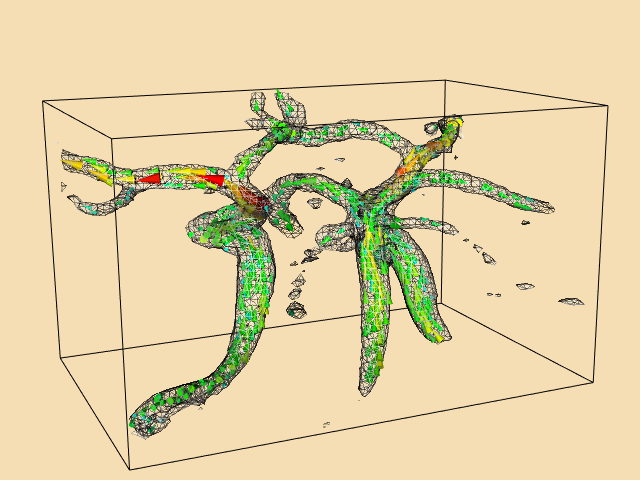CarotidFlowGlyphs
vtk-examples/Python/VisualizationAlgorithms/CarotidFlowGlyphs
Other languages
See (Cxx)
Question
If you have a question about this example, please use the VTK Discourse Forum
Code¶
CarotidFlowGlyphs.py
#!/usr/bin/env python
# noinspection PyUnresolvedReferences
import vtkmodules.vtkInteractionStyle
# noinspection PyUnresolvedReferences
import vtkmodules.vtkRenderingOpenGL2
from vtkmodules.vtkCommonColor import vtkNamedColors
from vtkmodules.vtkCommonCore import vtkLookupTable
from vtkmodules.vtkFiltersCore import (
vtkContourFilter,
vtkGlyph3D,
vtkMaskPoints,
vtkThresholdPoints
)
from vtkmodules.vtkFiltersModeling import vtkOutlineFilter
from vtkmodules.vtkFiltersSources import vtkConeSource
from vtkmodules.vtkIOLegacy import vtkStructuredPointsReader
from vtkmodules.vtkRenderingCore import (
vtkActor,
vtkCamera,
vtkPolyDataMapper,
vtkRenderWindow,
vtkRenderWindowInteractor,
vtkRenderer
)
def main():
fileName = get_program_parameters()
colors = vtkNamedColors()
ren1 = vtkRenderer()
renWin = vtkRenderWindow()
renWin.AddRenderer(ren1)
iren = vtkRenderWindowInteractor()
iren.SetRenderWindow(renWin)
# Create the pipeline.
#
reader = vtkStructuredPointsReader()
reader.SetFileName(fileName)
threshold = vtkThresholdPoints()
threshold.SetInputConnection(reader.GetOutputPort())
threshold.ThresholdByUpper(200)
mask = vtkMaskPoints()
mask.SetInputConnection(threshold.GetOutputPort())
mask.SetOnRatio(5)
cone = vtkConeSource()
cone.SetResolution(11)
cone.SetHeight(1)
cone.SetRadius(0.25)
cones = vtkGlyph3D()
cones.SetInputConnection(mask.GetOutputPort())
cones.SetSourceConnection(cone.GetOutputPort())
cones.SetScaleFactor(0.4)
cones.SetScaleModeToScaleByVector()
lut = vtkLookupTable()
lut.SetHueRange(.667, 0.0)
lut.Build()
scalarRange = [0] * 2
cones.Update()
scalarRange[0] = cones.GetOutput().GetPointData().GetScalars().GetRange()[0]
scalarRange[1] = cones.GetOutput().GetPointData().GetScalars().GetRange()[1]
print("range: ", scalarRange[0], ", ", scalarRange[1])
vectorMapper = vtkPolyDataMapper()
vectorMapper.SetInputConnection(cones.GetOutputPort())
vectorMapper.SetScalarRange(scalarRange[0], scalarRange[1])
vectorMapper.SetLookupTable(lut)
vectorActor = vtkActor()
vectorActor.SetMapper(vectorMapper)
# Speed contours.
iso = vtkContourFilter()
iso.SetInputConnection(reader.GetOutputPort())
iso.SetValue(0, 175)
isoMapper = vtkPolyDataMapper()
isoMapper.SetInputConnection(iso.GetOutputPort())
isoMapper.ScalarVisibilityOff()
isoActor = vtkActor()
isoActor.SetMapper(isoMapper)
isoActor.GetProperty().SetRepresentationToWireframe()
isoActor.GetProperty().SetOpacity(0.25)
# Outline
outline = vtkOutlineFilter()
outline.SetInputConnection(reader.GetOutputPort())
outlineMapper = vtkPolyDataMapper()
outlineMapper.SetInputConnection(outline.GetOutputPort())
outlineActor = vtkActor()
outlineActor.SetMapper(outlineMapper)
outlineActor.GetProperty().SetColor(colors.GetColor3d("Black"))
# Add the actors to the renderer, set the background and size.
#
ren1.AddActor(outlineActor)
ren1.AddActor(vectorActor)
ren1.AddActor(isoActor)
ren1.SetBackground(colors.GetColor3d("Wheat"))
renWin.SetSize(640, 480)
renWin.SetWindowName('CarotidFlowGlyphs')
cam1 = vtkCamera()
cam1.SetClippingRange(17.4043, 870.216)
cam1.SetFocalPoint(136.71, 104.025, 23)
cam1.SetPosition(204.747, 258.939, 63.7925)
cam1.SetViewUp(-0.102647, -0.210897, 0.972104)
cam1.Zoom(1.2)
ren1.SetActiveCamera(cam1)
# Render the image.
#
renWin.Render()
iren.Start()
def get_program_parameters():
import argparse
description = 'Visualizing blood flow in human carotid arteries.'
epilogue = '''
Cone glyphs indicate flow direction and magnitude.
'''
parser = argparse.ArgumentParser(description=description, epilog=epilogue,
formatter_class=argparse.RawDescriptionHelpFormatter)
parser.add_argument('filename', help='carotid.')
args = parser.parse_args()
return args.filename
if __name__ == '__main__':
main()
